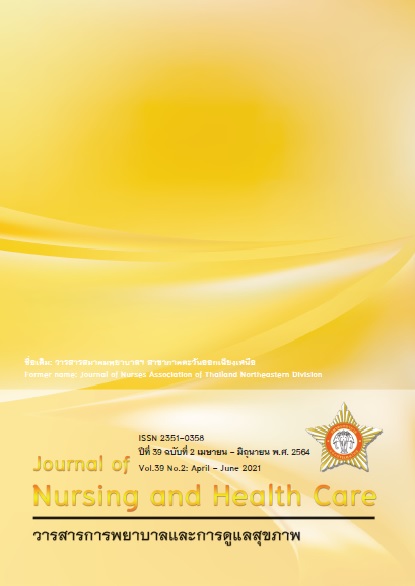บทบาทพยาบาลเวชปฏิบัติในการจ่ายยาสมุนไพรเพื่อรักษาโรคเบื้องต้น: ประยุกต์ใช้กระบวนการพยาบาล
คำสำคัญ:
บทบาทพยาบาลเวชปฏิบัติ, การจ่ายยาสมุนไพร, กระบวนการพยาบาลบทคัดย่อ
ปัจจุบันกระทรวงสาธารณสุขได้มีนโยบายส่งเสริมการใช้ยาสมุนไพรไทย สนับสนุนให้แพทย์และพยาบาลเวชปฏิบัติเพิ่มการใช้ยาสมุนไพรไทยในระบบบริการสุขภาพทุกระดับ เพื่อส่งเสริมให้เกิดการพึ่งพาตนเองและสร้างความมั่นคงด้านระบบยาในประเทศไทย อีกทั้งยังช่วยลดการนำเข้ายาแผนปัจจุบันจากต่างประเทศ ในหน่วยบริการสุขภาพระดับปฐมภูมิส่วนใหญ่ไม่มีแพทย์ปฏิบัติงานประจำ พยาบาลเวชปฏิบัติจึงเป็นผู้ที่มีบทบาทสำคัญในการสั่งจ่ายยาเพื่อการรักษาโรคเบื้องต้น และอาจต้องสั่งจ่ายรายการยาสมุนไพรเพิ่มมากขึ้นเพื่อตอบสนองต่อนโยบายส่งเสริมการใช้ยาสมุนไพรไทยของกระทรวงสาธารณสุข วัตถุประสงค์ของการเขียนบทความนี้เพื่อ 1) รวบรวมข้อมูลรายการยาสมุนไพรตามกรอบที่สภาการพยาบาลกำหนด 2) ศึกษาบทบาทพยาบาลเวชปฏิบัติในการจ่ายยาสมุนไพรเพื่อรักษาโรคเบื้องต้น โดยนำเอากระบวนการพยาบาล ได้แก่ การประเมินภาวะสุขภาพ การวินิจฉัยการพยาบาล การวางแผนการพยาบาล การปฏิบัติการพยาบาล และการประเมินผล มาประยุกต์ใช้ในการสั่งจ่ายยาสมุนไพรเพื่อการรักษาโรคเบื้องต้นอย่างเหมาะสมกับสภาพปัญหาของผู้รับบริการ
Downloads
เอกสารอ้างอิง
2. The Ministry of Public Health. Department of Development of Thai Traditional and Alternative Medicine. The 1st national master plan on Thai herbs development 2017-2021. Nonthaburi: TS interprint; 2016.
3. The Ministry of Public Health. Ask for cooperation in order to use first-line drug developed from herbs [record]. 13 september 2016.
4. National Drug System Development Committee. Herbal medicine account according to the announcement of the National Drug System Development Committee on the national major drug list of 2012. Nonthaburi: The Ministry of Public Health; 2013.
5. Meechumnarn T. Evaluation of the use of herbal and Thai traditional medicines in hospitals under the Ministry of Public Health in Roi-Et Province in 2014. Thai Jounal of Pharmacy Practice 2015; 7(2): 155-66.
6. Meksawasdichai C. Evaluation of policies promoting the use of herbal medicine in hospitals in the ministry of public health in Saraburi Province in 2017. Journal of Thai Traditional & Alternative Medicine 2019; 17(3): 516-26.
7. Nonting P, Charoenporn S, Kunwaradisai N, Watcharathanakij S, Vadhnapijyakul A. Situation and restrictions for the use of herbal medicines in public hospitals. Isan Journal of Pharmaceutical Sciences 2013; 9(1): 29. (in Thai)
8. Noipha K, Kamlungmak S, Chaimay B, Suwannarat R. Perception of using herbal medicines in national list of essential medicines among outpatients at internal medicine department and medical doctors in Phatthalung Hospital. Journal of Thai Traditional & Alternative Medicine 2017; 15(3): 333-51.
9. The Ministry of Public Health. Health resource information system of primary care unit. [cite 2020 Nov 17]. Available from: http://gishealth.moph.go.th/pcu/admin/report.php.
10. Ministry of Public Health. Office of the Permanent Secretary. Office of Public Health Administration. Family care team. Bangkok: The Agricultural Cooperative Federation of Thailand; 2014.
11. Thailand Nursing and Midwifery Council. Guide to use of drugs in primary medical care for registered nurse professionals and midwifery. 4th ed. Bangkok: Suruyod Printing; 2011.
12. Sub-committee for the preparation of Thai herbal medicine reference books. Khamin chan. Journal of Thai Traditional & Alternative Medicine 2014; 12(3): 245-50.
13. The Ministry of Public Health. Food and Drug Administration. National Drug and Information Division. National list of essential medicines. Announcement of the National Drug System Development Board on the National list of essential medicines (No. 2) B.E. 2555; 2012.
14. Jungsomjatepaisal P. Development of a prototype for promoting the use of herbal medicine in households in Thailand. Journal of Health Science 2019; 28(6): 1092-103.
15. Abdul-Aziz KK. Comparative evaluation of the anti-ulcer activity of Curcumin and Omeprazole during the acute phase of gastric ulcer. Food and Nutrition Sciences 2011; 2: 628-40.
16. Chuthaputti A, Pornpatkul V, Suwankiri U. The efficacy of Andrographis paniculate (Burm. F.) Wall. Ex nees for the relief of the symtoms of influenza. Journal of Thai Traditional & Alternative Medicine 2007; 5(3): 257-66.
17. George P. Concerns regarding the safety and toxicity of medicinal plants-An overview. Journal of Applied Pharmaceutical Science 2011; 1(6): 40-4.
18. Ma X, Peng JH, Hu YY. Chinese herbal medicine-induce liver injury. Journal of Clinical Translational Hepatology 2014; 2: 170-75.
19. Yang B, Xie Y, Guo M, Rosner MH, Yang H, Ronco C. Nephrotoxicity and Chinese herbal medicine. Clinical Journal of the American Society of Nephrology 2018; 13: 1605-11.
20. Xu X, Zhu R, Ying J, Zhao M, Wu X, Cao G, et al. Nephrotoxicity of herbal medicine and its prevention. Frontiers in Pharmacology 2020; 11: 1-15.
21. Chaiyawat C, Jamtaweekul J, Wongpentak S, Inthongkaew P. Safety of herbal medicines in the national list of essential medicines. Bulletin of the Department of Medical Sciences 2014; 56(3): 123-34.
22. Klinsoonthorn N, Nutsatapana C, Mapradit P. Survey of the quality of herbal medicine in the public health regions 4 and 5. Bulletin of the Department of Medical Sciences 2014; 56(1): 40-51.
23. Mosihuzzaman M. Herbal medicine in healthcare-an overview. Natural Product Communications 2012; 7(6): 807-12.
24. Harnyoou O. Nursing process and implications. Journal of The Royal Thai Army Nurses 2014; 15(3): 137-43.
25. Aussawapronwiput W. Standards of nursing care: nursing process and professional ethics. Public Health & Health Laws Journal 2016; 2(3): 393-400.
26. Intahphuak S. Medication error reduction: applying nursing process in drug administration. Journal of Nursing Science & Health 2014; 37(4): 139-46.
27. Talordpong P, Pibanwong P. Roles of nursing practitioner in the use of drug in elderly patients. Vajira Medical Journal: Journal of Urban Medicine 2018; 2(6): 473-82.



